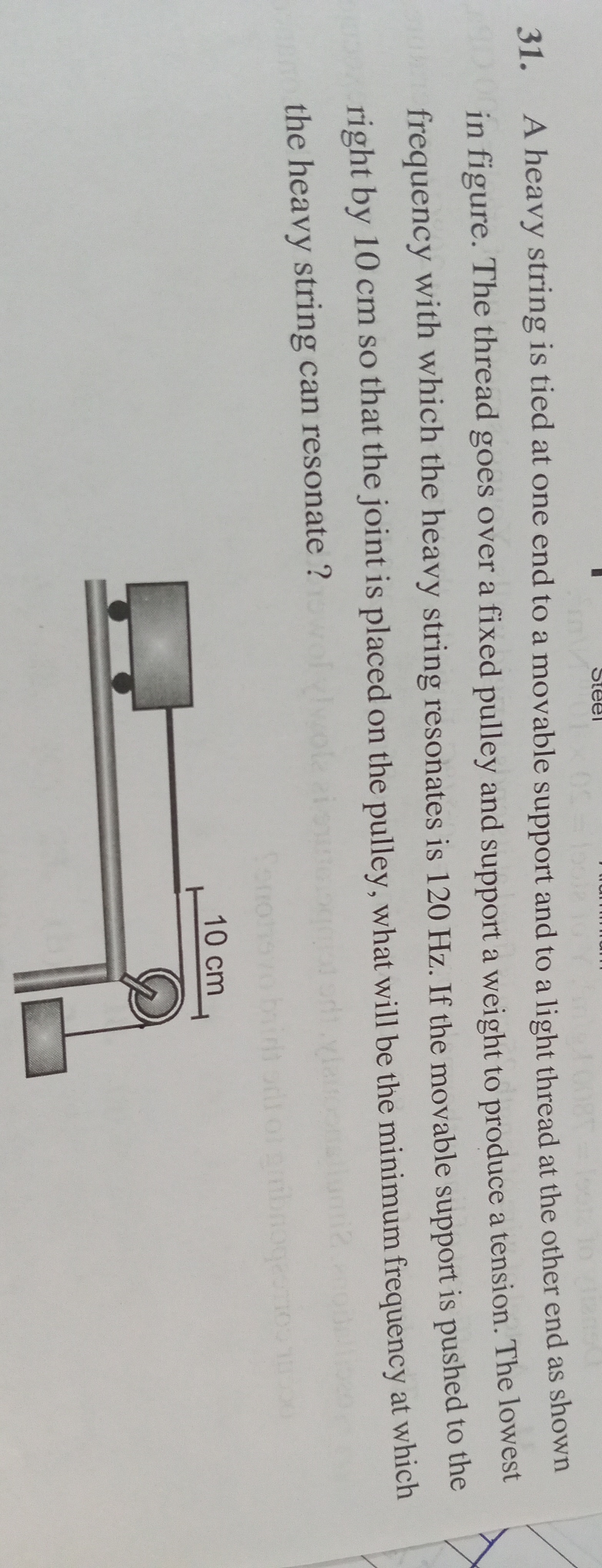Question
Question: A heavy string is tied at one end to a movable support and to a light thread at the other end as sho...
A heavy string is tied at one end to a movable support and to a light thread at the other end as shown in figure. The thread goes over a fixed pulley and support a weight to produce a tension. The lowest frequency with which the heavy string resonates is 120 Hz. If the movable support is pushed to the right by 10 cm so that the joint is placed on the pulley, what will be the minimum frequency at which the heavy string can resonate ?

240 Hz
Solution
The heavy string is fixed at both ends: at the movable support and at the pulley (where it is connected to the light thread). Let the initial length of the heavy string be L1. The speed of transverse waves in the string is v=μT, where T is the tension and μ is the linear mass density. The resonance frequencies for a string fixed at both ends are given by fn=2L1nv=2L1nμT, where n=1,2,3,…. The lowest frequency is the fundamental frequency, which corresponds to n=1: f1=2L11μT. We are given that the lowest frequency is 120 Hz, so f1=120 Hz.
The movable support is pushed to the right by 10 cm. From the figure, the movable support is to the left of the pulley. Pushing it to the right means moving it towards the pulley. The initial length of the heavy string is the distance from the movable support to the pulley. Let the initial position of the movable support be x1 and the position of the pulley be xp. The initial length is L1=xp−x1. The movable support is pushed to the right by 10 cm, so its new position is x2=x1+10 cm. The heavy string is now between the new position of the movable support and the pulley. The new length of the heavy string is L2=xp−x2=xp−(x1+10)=(xp−x1)−10=L1−10 cm. So, the new length of the heavy string is L2=L1−10.
In the new setup, the heavy string is still fixed at both ends, with length L2. The tension T and linear mass density μ remain unchanged. The minimum frequency at which the heavy string can resonate is the new fundamental frequency, f1′. f1′=2L21μT=2(L1−10)1μT.
We have the initial fundamental frequency f1=2L11μT=120 Hz. From this, we can write μT=2×120×L1=240L1. Substitute this into the expression for f1′: f1′=2(L1−10)1(240L1)=L1−10120L1.
Let's assume the initial length of the heavy string is L1 and the final length is L2. The movable support is pushed to the right by 10 cm, which means the length of the string is reduced by 10 cm, so L2=L1−10. We are given f1=120 Hz. We want to find f1′. f1∝L11 and f1′∝L21. f1f1′=L2L1=L1−10L1. f1′=120×L1−10L1.
Let's assume from the figure that the initial length of the heavy string is L1 and the movable support is moved by 10 cm to the right, and the new length is L2. The figure shows the movement of 10 cm. Let's assume the initial length is L1 and the final length is L2. The movement is 10 cm. If the movement is towards the pulley, L2=L1−10.
Let's assume the initial length is L1 and the final length is L2. The movement is 10 cm. If the initial length was L1 and the final length is L2, and L1=2L2, and the movement is 10 cm, then L1−L2=10, so 2L2−L2=10, which means L2=10 cm and L1=20 cm.
If we assume L1=20 cm, then L2=20−10=10 cm. f1′=12020−1020=1201020=120×2=240 Hz.
Therefore, the minimum frequency at which the heavy string can resonate is 240 Hz.
